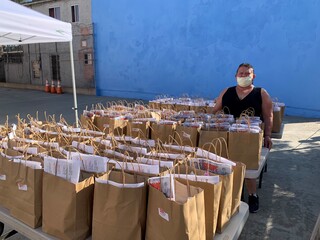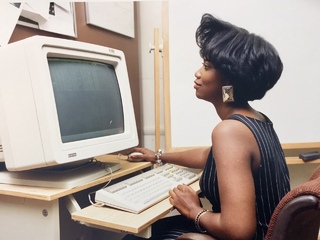Julia Marshall met David Crisp during an earthquake.
Both had been separately invited to a 2011 meeting in Japan by the Japan Aerospace Exploration Agency (JAXA), an hour's train ride away from Tokyo. Julia had bought her first business suit for the occasion, and was standing at the podium, dressed to impress. But as she began her talk, the building started shaking.
“At first, I thought it wasn’t a big deal,” Julia remembers, “because they have earthquakes in Japan all the time. No one else was freaking out, so I thought I’d just keep giving my talk and be professional.”
But the earthquake went on and on. The projector hanging from a ceiling mount was wiggling, the walls started to flex, and her ears were popping. Looking out at the sea of blank faces staring back at her, Julia caught the eye of David Crisp, a fellow carbon scientist she had only just met. “Should I stop?” Julia mouthed at him.
“Yeah, you should stop,” he mouthed back. An orderly retreat under the tables commenced, and when the earthquake finally stopped, everyone evacuated the building. The meeting was adjourned. The grocery stores were soon stripped of supplies, and power and running water were cut at the hotel. And tragically, on the coast, a horrific tsunami generated by the earthquake drowned about 20,000 people. In those circumstances – just two stranded foreigners trying to make it back home – Julia and Dave became fast friends.
It just so happened she had befriended one of the top scientists in her field – "a bigshot from NASA-JPL" as she described him to her anxious family back home, who had been waiting for news of her safety. “I felt special because I got to know him under such uncommon circumstances. But I later found out, Dave has close relationships with so many other people.”
The deep network of collaborators and friends that Dave built spans from Australia to Japan and back to his home base at NASA’s Jet Propulsion Laboratory in Southern California. He’s traveled far and wide. Wherever he goes, he brings with him expert knowledge of how to measure carbon dioxide in Earth’s atmosphere from space.
Dedication and Goodwill
Yasjka Meijer remembers well Dave’s frequent trips to the Netherlands, where they had meetings to support a new carbon-monitoring satellite from Europe’s Copernicus Program. “He’d be coming to our meetings sometimes directly after stepping off the plane following a 10-hour flight. He’d sit next to the coffee machine to stay awake. And he would sometimes doze off for a bit. But as soon as he woke up, he’d make a comment that was right to the point.”
Jetlagged or not, there was a reason Dave was so welcome at satellite advisory meetings like this. Measuring carbon from space is an intensely challenging thing to do. In fact, it wasn’t so long ago that people weren’t even sure if this could be done. But Dave was instrumental in building JPL’s series of Orbiting Carbon Observatory satellites. Because of that experience, Dave says, “I can help other space agencies stay on the right track. I know when the sensors are good enough and not going to get better. I can tell people like Yasjka, ‘Stop here, it’s good enough. You don’t have to make up new physics.’” Sharing knowledge like this between partners helps ensure that no matter what country launches the mission, it will collect high-quality data on levels of carbon in the atmosphere.
Atmospheric scientist Akihiko Kuze from JAXA also worked closely with Dave. Under Kuze’s leadership, JAXA was developing their own “GOSAT” series of carbon-monitoring satellites at the same time that JPL was enmeshed with OCO. The two sets of teams supported each other closely, and made frequent visits to the other’s facility.
One memory that Kuze holds especially dear was when JAXA organized a special program for Japanese high-school students in the city of Nara. Nara served as Japan’s capital city over a thousand years ago, and is still dotted with ancient temples. It was in one of these temples that David Crisp regaled his audience as the main speaker of the program. “He was very good with the high school students,” Kuze remembers. “He was very kind, and spoke slowly and clearly in English about Earth observations from space. It was a very impressive lecture, and the next day, the local newspaper mentioned it with praise.”
This was the sort of impression Dave left with most people he met. “He always built goodwill,” Julia says. “So when he asked you to do something, people would say, ‘Okay, I don’t actually have time, but I’ll do it for Dave.’”
Stopping to smell the roses
Now, after so many decades of work in this field, and having built his giant web of contacts, Dave Crisp is going to retire. Over the last few weeks, both his colleagues at JPL and his international contacts like Yasjka have organized pandemic-safe virtual good-bye parties for him. For Julia, it’s not even Dave’s technical expertise that she’ll miss the most. “I’ll miss him,” she says simply. “I’ll miss seeing him. We’ve had great times together.”
When you talk to Dave, though, you get a sense of a person with 50 million more meetings he wants to attend, not someone who’s about to go relax. He acknowledges there’s a part of him still lured by his work. “Maybe what’s left of the kid in me wants to keep going. But I’m not really young enough to do 14- and 16- hour days as I try to support meetings in Japan, Australia, Europe, and the U.S. After a while, you’ve got to realize that things around you are changing and it’s time to take off and smell the roses.”
As for what “smelling the roses” will look like for Dave, it’s an open question. “I literally don’t know,” he says. “I’m putting in a hard stop right after I retire, and then I’ll think about what the heck I want to do with the rest of my life.”






